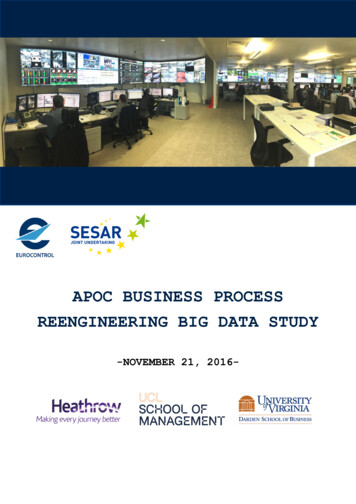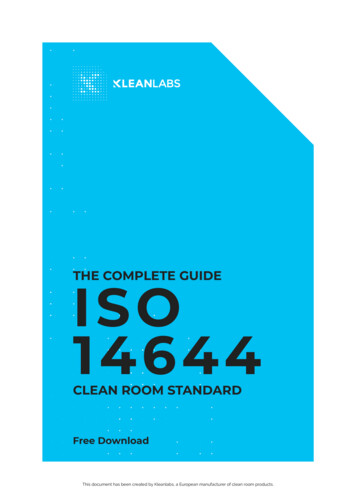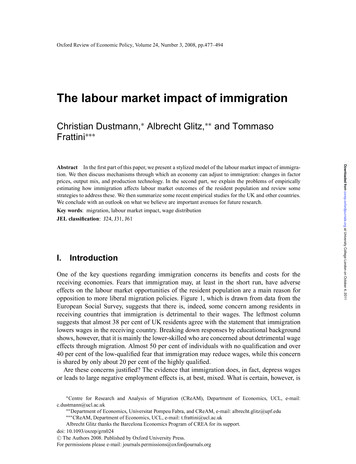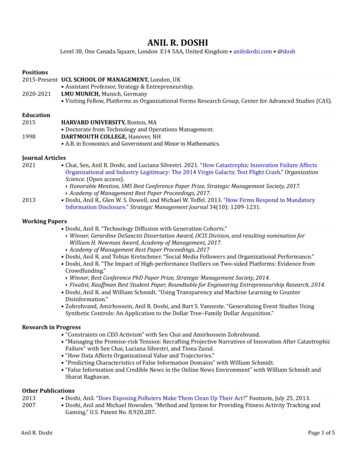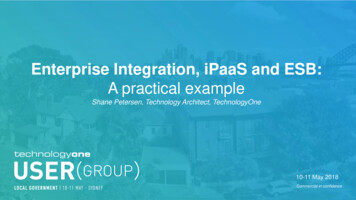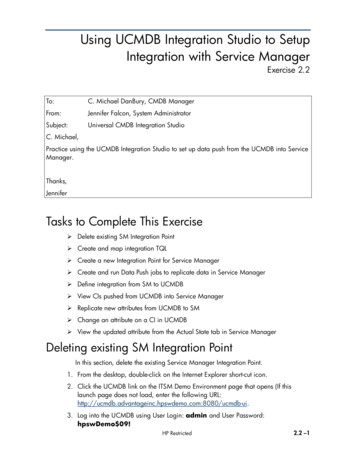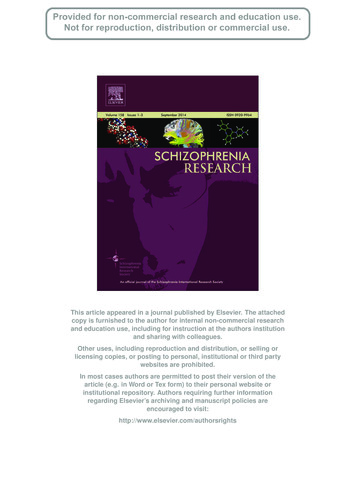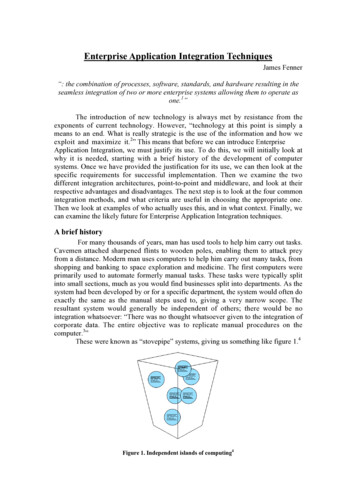
Transcription
Enterprise Application Integration TechniquesJames Fenner“: the combination of processes, software, standards, and hardware resulting in theseamless integration of two or more enterprise systems allowing them to operate asone.1”The introduction of new technology is always met by resistance from theexponents of current technology. However, “technology at this point is simply ameans to an end. What is really strategic is the use of the information and how weexploit and maximize it.2” This means that before we can introduce EnterpriseApplication Integration, we must justify its use. To do this, we will initially look atwhy it is needed, starting with a brief history of the development of computersystems. Once we have provided the justification for its use, we can then look at thespecific requirements for successful implementation. Then we examine the twodifferent integration architectures, point-to-point and middleware, and look at theirrespective advantages and disadvantages. The next step is to look at the four commonintegration methods, and what criteria are useful in choosing the appropriate one.Then we look at examples of who actually uses this, and in what context. Finally, wecan examine the likely future for Enterprise Application Integration techniques.A brief historyFor many thousands of years, man has used tools to help him carry out tasks.Cavemen attached sharpened flints to wooden poles, enabling them to attack preyfrom a distance. Modern man uses computers to help him carry out many tasks, fromshopping and banking to space exploration and medicine. The first computers wereprimarily used to automate formerly manual tasks. These tasks were typically splitinto small sections, much as you would find businesses split into departments. As thesystem had been developed by or for a specific department, the system would often doexactly the same as the manual steps used to, giving a very narrow scope. Theresultant system would generally be independent of others; there would be nointegration whatsoever: “There was no thought whatsoever given to the integration ofcorporate data. The entire objective was to replicate manual procedures on thecomputer.3”These were known as “stovepipe” systems, giving us something like figure 1.4Figure 1. Independent islands of computing4
This “islands of automation” model was abandoned gradually for threereasons: 31. It became increasingly necessary to allow the systems to interact. This meantthe existing systems had to be integrated to provide interoperability – the scalemeant that you couldn’t simply start again!2. The realisation that customer information within the stovepipe system hadmassive value, particularly when viewed as a whole. For example, a softwarevendor may have separate systems for home, business and government client,and no way to obtaining a global view of the information.3. The desire to integrate key systems with vendors and customers.As integration became more and more important, systems would tend to lookmore like figure 2. 3Figure 2. The integrated enterprise3This brings us (nearly) up to the present. In the last decade, packaged softwaresolutions became very popular. Software such as SAP, Oracle ERP, PeopleSoft,JDEdwards, Siebel and Clarify would tend to work well individually, but again,would create “information islands” as before, albeit on a larger scale. When commondata had to change, it had to be updated manually. For example, in a German bank,clerical staff would read from one screen and type data into a user interface of anotherapplication. This was slow, and generated many errors5. Also, “the furtherproliferation of packaged applications, applications that addressed the potentialproblems of the Year 2000, supply chain management/business-to-business (B2B)integration, streamlined business processes, web application integration, and overalltechnology advances6” meant that long term scalable solutions were required. Thesesolutions are called “Enterprise Application Integration” (EAI) techniques.
EAI RequirementsNow that the need for EAI has been recognised, we must continue byexplaining what EAI must involve in order to be a realistic solution. It must coverevery part of an enterprise system, including architecture, hardware, software andprocesses.1 Business Process Integration (BPI): It is fundamentally important for acorporation to specify the processes involved in the exchange of enterpriseinformation. “This allows organizations to streamline operations, reduce costs andimprove responsiveness to customer demands7.” This can include processmanagement, process modelling, and workflow. Here, we involve the combinationof tasks, procedures, organizations, required input and output information, andtools needed for each step in a business process. 1 Application Integration: Here, the goal is to “bring data or a function from oneapplication together with that of another application that together provide nearreal-time integration8.” This can include, business-to-business integration,customer relationship management (CRM) systems which can be integrated with acompany's backend applications, web integration, and building web sites thatinteract with multiple business systems.1 Data Integration: If we want the above two integrations to succeed, we must alsointegrate the data involved. Its location must be identified, recorded, and ametadata model must be built (a master guide for various data stores). Now, datacan be shared or distributed across database systems, providing it is in a standardformat such as COM /DCOM, CORBA, EDI, JavaRMI, and XML.1 Platform Integration: Finally, the separate needs of the heterogeneous networkmust be integrated. Platform Integration deals with the processes and tools that arerequired to allow these systems to communicate, both optimally and securely, sodata can be passed through different applications without difficulty. For example,finding how an Apple can pass data to a wireless palmtop is part of the entirecorporate system integration.1These activities, as we have said, are essential if EAI is to replace theunsatisfactory integration techniques that we have arrived at through time.EAI Integration Architectures9 Within EAI, there exist two types of integration architecture:Direct point-to-point (PTP)Middleware-basedPoint-to-PointThis is the basic, more traditional approach. It is used because it is easy andquick, certainly viable for situations where we have few systems to integrate. Forexample, a new web site may need to interface with an existing sales order system andpoint-to-point integration may appear suitable. However, as you integrate additionalapplications, you get a situation like that shown in Figure 3:10
Figure 3. The later stages of a point-to-point integration9As this solution scales up, the infrastructure proves brittle. The tight coupling,dependence, and number of integration points are all major disadvantages. The eightapplications shown in figure 3 are using a total of 12 integration points, all of whichneed support. In theory, you could need up to double the number of integration pointscompared to the number of applications, as shown in figure 4, where the fiveapplications need ten points of integration:88Figure 4. Number of point-to-point connectionsIf we want to avoid this, we need to provide an intermediate layer that canisolate the changes between applications, effectively reducing the coupling. To dothis, we use middleware.MiddlewareAs we have said, we need to provide something to mediate betweenapplications. By using middleware, we can provide generic interfaces, which allowapplications to pass messages to each other. Each of these interfaces defines a processthat the application provides. In figure 5, we can see a logical depiction of thisprinciple: 8
8Figure 3. Middleware-based integrationNow, our five applications only have five integration points, potentiallyhalving this cost. We can also add and replace applications in a manner that does notaffect other ones. The middleware itself can perform operations such as routing,transforming, aggregating, separating, and converting on the data that is passed. Notehowever, that there is additional complexity in terms of setting up the middleware,and converting the applications to use the middleware APIs.The Four Integration methods8Once the logical EAI architecture has been selected, we can move onto theactual integration method that is suitable to use. There are four common integrationmethods: Data-level integration User interface (UI)-level integration Application-level integration Method-level integrationData-level integrationHere, the backend data stores of the relevant application are integrated, andcan be either push or pull based. When using push based, one application makes SQLcalls on another application’s database tables. This is through database links or storedprocedures, and data is pushed into another application’s database. However, pullbased integration uses triggers and polling. The triggers capture changes to data andwrite the identifying information to interface tables. It is then possible for adaptors topoll the application’s interface tables and retrieve the pertinent data. This pull basedintegration is used when an application requires passive notification of changes withinanother application’s data.When the application that needs to be integrated does not provide any APIs orclient interfaces, you would use data-level integration. You must also have a goodunderstanding of the business operations that may affect the application’s data model.It is typically the only option with most custom applications that lack APIs.User Interface-level integrationThis ties integration logic to user interface code, and can be either scripting or proxybased. When using scripting based, the integration code is embedded into the user
interface component events, common with client/server applications such asPowerBuilder or Vantive.In cases where direct access to the database is not easy or possible, or whenthe business logic is embedded in the user interface, this is the correct integrationmethod to use. Mainframe and client/server applications are often good candidates forthis. Mainframes do not tend to have access to friendly data stores, and do not providepublic APIs. However, user interface level integration is generally used as a lastresort. If you add scripting logic to catch events with client/server applications theybecome very difficult to maintain, as integration levels increase and more changesoccur. User interface changes can break integration triggers and logic anyway. Thistight coupling creates a permanent link between the maintenance of the user interfaceand the integration code.Application-level integrationThis is considered the best way forward for application integration, and it usesthe integrated application’s integration frameworks and APIs. It is good to use, sinceit is transparent to the integrated application and it preserves the application’s dataintegrity. The application interface allows you to invoke business logic to preservedata integrity. Integration API examples include Siebel's Java DataBeans and SAP'sJCA (J2EE Connector Architecture).Method-level integrationThis is less frequently used specialisation of the application level integration methodshown above. Here, we aggregate common operations on multiple applications into asingle application that fronts the integrated applications. It is generally used wheneach integrated application has a similar set of API or functional methods. Theintegrated applications must support a Remote Procedure Call (RPC) or distributedcomponent technology. The main disadvantage to this approach is again the tightapplication coupling in front components. They will break when changes are made tothe integrated application API, and these problems will propagate down to the otherapplications that rely on them. This is used when we have distributed component orCORBA technology.How to choose an integration method? 8This is really an exercise in constraint-based modelling. You must look at eachsystem and define the possible interfaces into that application. In some cases, theapplication does not have any API; therefore the backend data store represents theonly option. In other cases, APIs and a CORBA infrastructure may exist; so employapplication-level integration. 8But who uses this?It’s all very well having a well-defined integration system, but without thebacking of major industry, these techniques will soon disappear. Fortunately thereexists a massive backbone in the large multi-national companies to supportdevelopment of EAI. Market leaders include BEA Systems, CrossWorlds Software,IONA Technologies, Level 8 Systems, Mercator Software, NEON (purchased in 2001by Sybase), SeeBeyond, Software AG, TIBCO, Vitria Technology, and webMethods.Market-leading large system integration firms include IBM Global Services,
Accenture, PricewaterhouseCoopers, CSC, and EDS1. So, we really do have largecurrent support for the use of EAI.For an example of the type of work a typical EAI company might do, see table1 below11:Project NameBusiness Support SystemRussian Government AgencyforApril 2001 - December 2002(planned)International PaperAugust 2001 - December 2001Electronic Mail System for RussianMinistry of RailwaysAugust 2001 - June 2002Description and TechnologiesThe project is covered by a NDA so only a general description can be provided. The maincontractor is one of the world's largest IT companies. Digital Design is developing the softwarepart of the solution worth almost 1 million USD. The system is integrated with a standardindustrial document management system, a search engine, and an Oracle database.Order-tracking system for client support personnel and company management. The system isintegrated with Scala ERP, Prodis (production control system) and TPC (TransportationProcess Control system). Main functionality is to provide information about order placement,production, stock availability, credit control, transportation and customer claims. The system isbeing used in the production environment serving a large number of International Paper'sclients' requests.The client used to have independent IT policies in its 22 subsidiary companies. Digital Designdeveloped a number of applications providing connectivity between different messagingplatforms and catalogues. The system is being used by 50,000 users in 11 time zones. On top ofthis messaging system, Digital Design rolled out HP Open View Operations to manage both theclient's corporate network and the Electronic Mail System from a single centralized location.This was done using SOAP, a leading edge technology which provides many advantages, suchas seamless integration of various applications over the Internet.Table 1. Use of EAI in Industry11What for the future?EAI is still a maturing technology, but seems to have a brilliant future. Why?To put it simply “It's the economy, stupid.12” The EAI market is set to become themost important and fastest growing IT sector in the next three to five years.Apparently, “worldwide revenues in this market will jump from 5 billion in 2000 tonearly 21 billion in 2005. This increase represents a strong compound annual growthrate (CAGR) of over 30%. By comparison, the corresponding opportunity of theoverall IT services industry will increase at a CAGR of 11% during the sameperiod.13” This growth will also be primarily felt in this part of the world “NorthAmerica and Western Europe will generate more than 90% of the demand for globalEAI services through 2005, with Japan and Latin America driving the remainder ofthis service demand.12” It is not therefore surprising that so many major companiesare involved as we have previously seen. However, there are factors that may slow thepredicted growth, which are the “cost of services, human issues regarding EAIengagements, and business-to-business integration challenges.12”But what does this all mean for a modern company? Vendors will emerge tolead the market, vendors who have accumulated additional layers of applicationcontent knowledge. Rather than just using a propriety tool, they will be able to choosefrom “a toolbox of possible technologies1”, each of which will be particularly suitedto whatever the current project may be. They will be able to offer economicalintegration services, more economical than those available to us now. This will bepartly because they can avoid costly trial and error testing, due to their familiaritywith the capabilities and limitations of the products, and as they can leverage theirinvestment in application knowledge and process development. They will alsounderstand the most important questions to ask customers about their softwareproduct, and this enhanced relationship will allow them to provide more economical,reliable maintenance and support of evolving customer integration requirements1.” Itis therefore clear that although there are massive financial possibilities to beexploited, there is much work required to achieve the previously stated goals.
ConclusionSo, we have seen that EAI is an important tool for any company in the ITindustry. We have looked at its roots, and why it has been developed, and this has ledus to define criteria for successful integration. We then moved onto the EAIintegration architectures, and then examined the integration methods. Then we lookedat the use of EAI in industry and the future it holds. It certainly seems that theimportance can only grow.1EAI.ITtoolbox.comCIO magazine 1st July 2002, former Wal-Mart CIO Kevin Turner3William Inmon, "A Brief History of Integration." EAI Journal.4XML and Java, Todd Sundsted5Emmerich, Tigra6John P. Desmond and Ed Acly, "Beating the Integration Blues." Software Magazine.September 1999.7Andre Yee, "Demystifying Business Process Integration." EaiQ.8www.gartner.com9EAI using J2EE, Abraham Kang10Anonymous CITL Consultant11Digital Designs UK Ltd121992 US Democratic campaign slogan13IDC, "The EAI Market Simmers with Robust Growth Expectations." February 28, 2001.2
Enterprise Application Integration Techniques James Fenner ": the combination of processes, software, standards, and hardware resulting in the seamless integration of two or more enterprise systems allowing them to operate as one.1" The introduction of new technology is always met by resistance from the exponents of current technology.
